|
...the wonderful Chester Market Hall, seen here just before its unforgivable demolition in 1964.
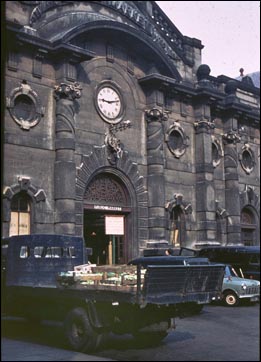 The following lament for the passing of the Chester Market Hall was written by Mr F. Turley and was published, a few years after the events, in the September 1967 edition of the Cheshire Sheaf… The following lament for the passing of the Chester Market Hall was written by Mr F. Turley and was published, a few years after the events, in the September 1967 edition of the Cheshire Sheaf…
"The Chester Market Hall closed its doors to the public for the last time on Saturday, the 17th June, 1967, after serving generations of shoppers from a wide area for more than a century. With its architecturally heavy stone facade it was, and it looked like, a solid Victorian market place, typical of so many built throughout Britain in the nineteenth century. Affection for it was warm and widespread, and nostalgia for the friendly old haunt will remain with many Cestrians long after new shopping habits have been formed in its swagger modern successor.
In the winter of 1861/62 demolition was proceeding in a closely built-up area on the west side of Northgate Street north of Hamilton Place to provide a site for the new Market Hall. Later in 1862 the Exchange was to be destroyed by fire necessitating further demolition as far north as Princess Street to provide a site for the new Town Hall which was opened in 1869. Many well known buildings stood within this area. Dixon and Wardens Bank, the old White Lion hotel, and the Saracens Head inn were amongst them, and those buildings which managed to survive the demolition for the new Market were caught up in the clearance of the adjoining site for the new Town Hall on which building commenced in 1865.
On Tuesday the 8th April 1862 a procession consisting of the Mayor and Corporation led by the Blue Coat School Band made its way from the Exchange (Town Hall) to the Royal Hotel (converted to the Grosvenor Hotel in 1866) where it was joined by a party of Freemasons and a Guard of Honour to proceed to the site of the new Market Hall in the following order:
Chester Rifle Volunteers Band, Chester Artillery and Rifle Volunteers Guard of Honour, the Mayor John Trevor Esq., the Magistrates, the Sheriff Joseph Oakes Esq., the Town Council and Citizens, Blue Coat School Band, Cestrian Lodge of Freemasons and Visitors, Chester Rifle Volunteers Guard of Honour.
On arrival at the site the various officials took up predetermined positions and the Worshipful Master of the Cestrian Lodge, Bro Walter Butler, called upon the Mayor to perform the ceremony of laying the foundation stone with Masonic formalities. The engraved trowel made by Mr. Butt, silversmith of Eastgate Street, was the gift of the Magistrates and Corporation and was presented to the Mayor by Mr P. S. Humberston, M.P. for the city. The chaplain, the Rev. J F. Hewson then offered up a prayer, and, after the Mayor had inspected the plans, the inscription on the plate was read out as follows:—
"This stone was laid with Masonic ceremonies by the Right Worshipful the Mayor of Chester John Trevor Esq on Tuesday the 8th day of April 1862. Architects- Messrs W. and J. Hay, Liverpool. Contractor- Mr. John Roberts, Chester."
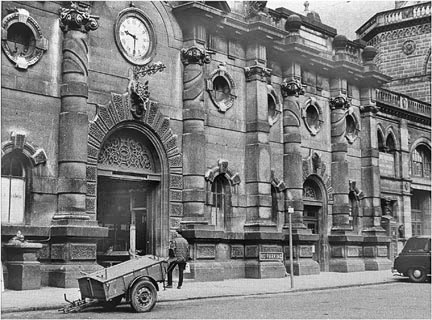 The Treasurer of the Corporation, Mr. Edward Stokes-Roberts, then placed a bottle containing the current coins of the Realm in the prepared cavity of the stone, and closed up the aperture with the brass plate. The Mayor then spread the mortar, and the stone was slowly lowered on to its bed as the Volunteers presented arms and their band played the National Anthem. The plumb rule, level square, and mallet, were succesively handed to the Mayor after which he pronounced the stone duly laid. The Treasurer of the Corporation, Mr. Edward Stokes-Roberts, then placed a bottle containing the current coins of the Realm in the prepared cavity of the stone, and closed up the aperture with the brass plate. The Mayor then spread the mortar, and the stone was slowly lowered on to its bed as the Volunteers presented arms and their band played the National Anthem. The plumb rule, level square, and mallet, were succesively handed to the Mayor after which he pronounced the stone duly laid.
The photograph on the left was taken by Eddie Argyle and features on the Chester Photographic Society's excellent galleries pages.
We're grateful to them for allowing its reproduction here.
The Mayor then offered up a short Masonic prayer after which the following presentations were made to him:—
The cornucopia containing corn by P. M. Bro James Gerrard.
A silver cup containing wine by P.M. Bro Burghall.
A silver cup containing oil by P.M, Bro Chorlton (Lodge of Light 173).
A silver measure filled with salt by P.M. Bro Pigot.
As the Mayor poured the contents of each cup onto the stone he pronounced the following invocation:-
"May the all bounteous Author of Nature, bless this city witih abundance of corn, wine, oil and salt, and with all the necessaries. conveniences, and comforts of life." After an address by the Mayor to the whole assembly the chaplain closed the ceremony with a blessing, and the procession returned to the Royal Hotel in the same order as it had arrived.
The building operations went ahead without a hitch, and the market was opened to the public on the 10th March 1863 during the festivities on the occasion of the wedding of the Prince of Wales who, in 1901, succeeded his mother Queen Victoria to become King Edward VII.
From 1863 to 1967, in peace and war, the old Market Hall has played its intended role in trying to fulfil the high hopes set by Mayor John Trevor's invocation,
and now, in its turn, after staging daily scenes of ceaseless activity and noisy animation, it stands strangely still and silent, empty and forlorn, waiting to be brusquely swept away into the long history of Chester by tlhe restless and relentless hammers of the insatiable demolishers".
The previous page has
some
more
images
of
the
changing
face
of
the
Market
Square.
To
learn
something
of
the
history
of
this
fascinating
part
of
the
city,
go here-
and here are
details
of
the great changes
planned
for
the
area
in
the
near
future... |

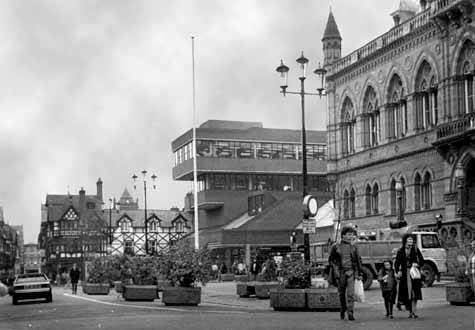
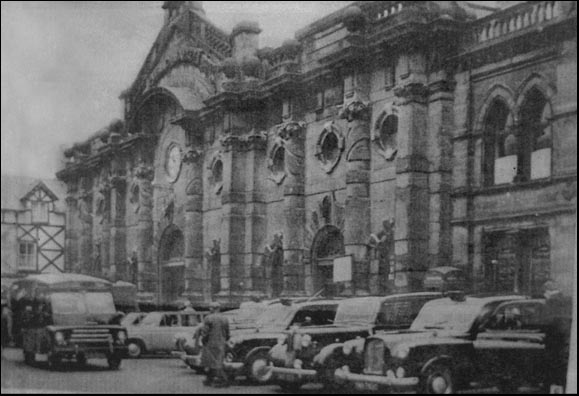
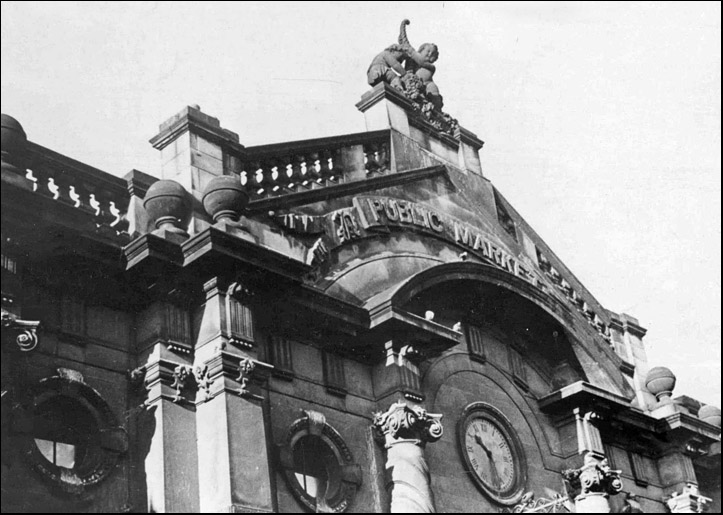
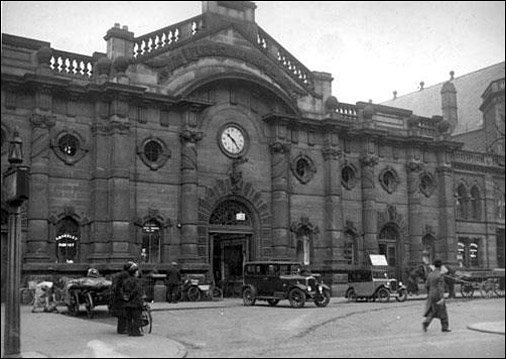
 The following lament for the passing of the Chester Market Hall was written by Mr F. Turley and was published, a few years after the events, in the September 1967 edition of the Cheshire Sheaf…
The following lament for the passing of the Chester Market Hall was written by Mr F. Turley and was published, a few years after the events, in the September 1967 edition of the Cheshire Sheaf… The Treasurer of the Corporation, Mr. Edward Stokes-Roberts, then placed a bottle containing the current coins of the Realm in the prepared cavity of the stone, and closed up the aperture with the brass plate. The Mayor then spread the mortar, and the stone was slowly lowered on to its bed as the Volunteers presented arms and their band played the National Anthem. The plumb rule, level square, and mallet, were succesively handed to the Mayor after which he pronounced the stone duly laid.
The Treasurer of the Corporation, Mr. Edward Stokes-Roberts, then placed a bottle containing the current coins of the Realm in the prepared cavity of the stone, and closed up the aperture with the brass plate. The Mayor then spread the mortar, and the stone was slowly lowered on to its bed as the Volunteers presented arms and their band played the National Anthem. The plumb rule, level square, and mallet, were succesively handed to the Mayor after which he pronounced the stone duly laid.